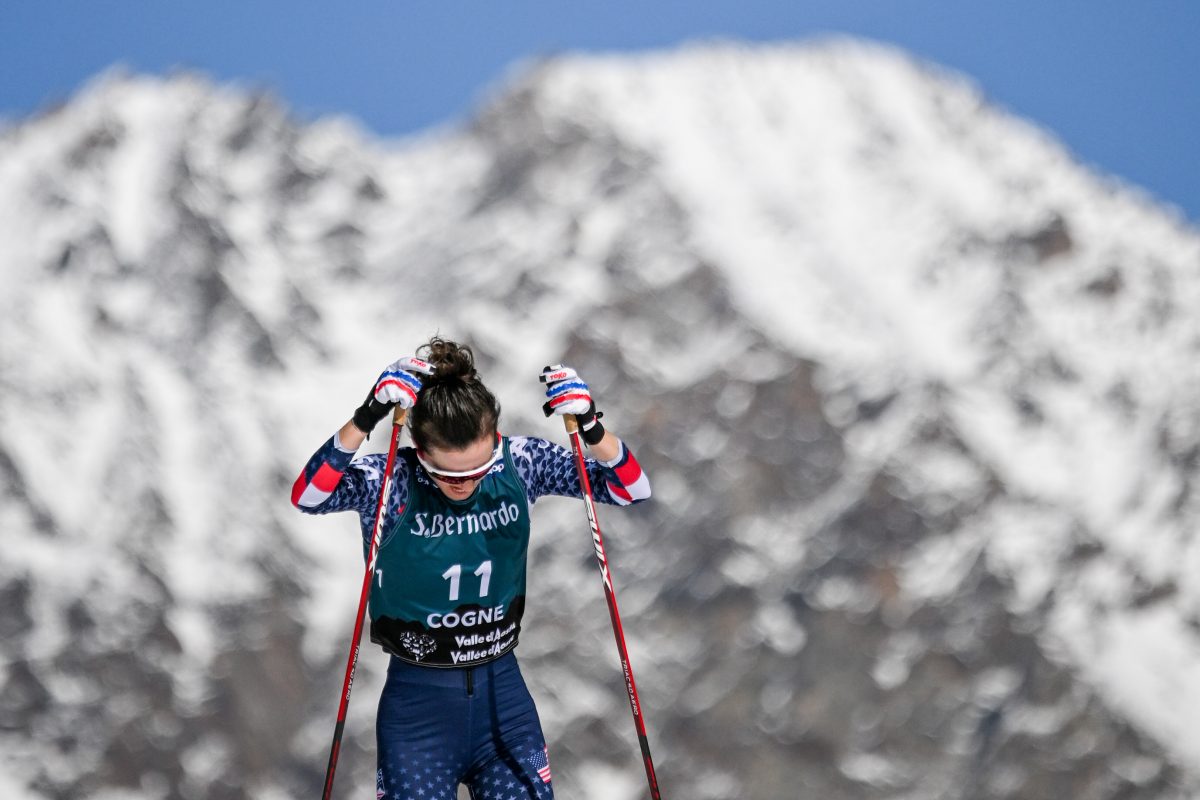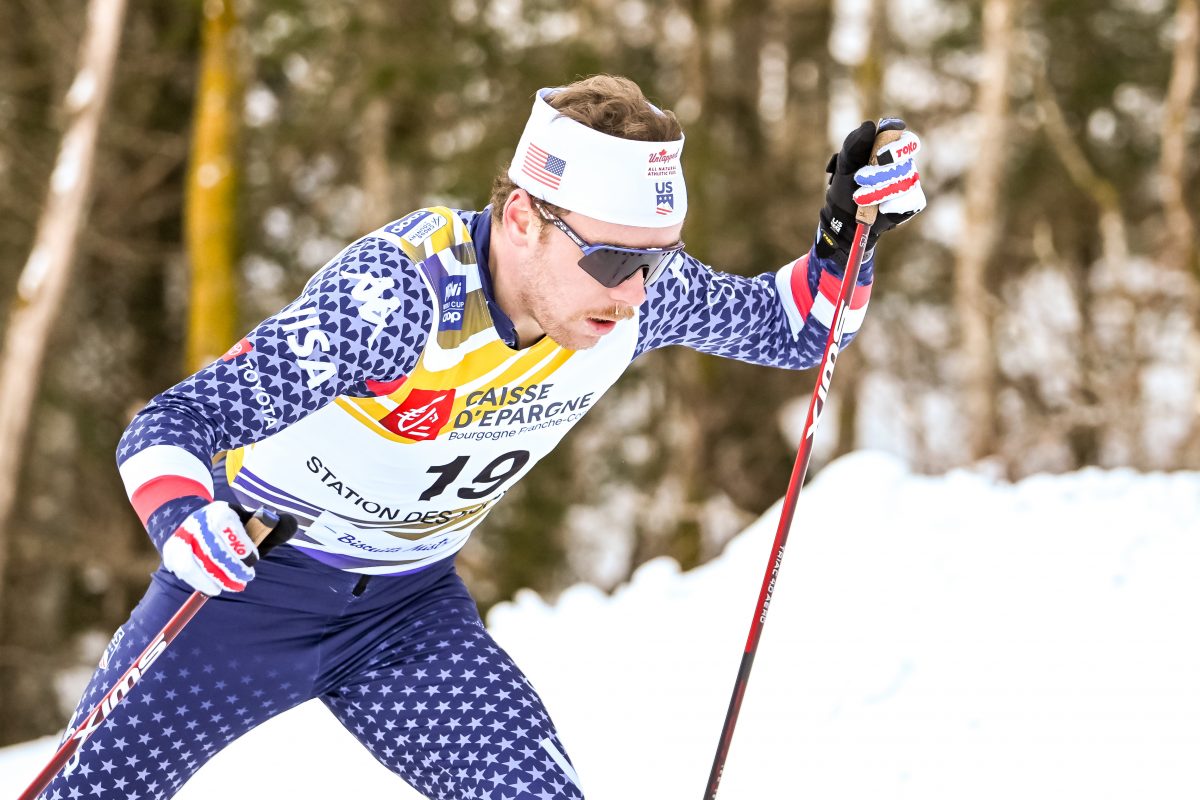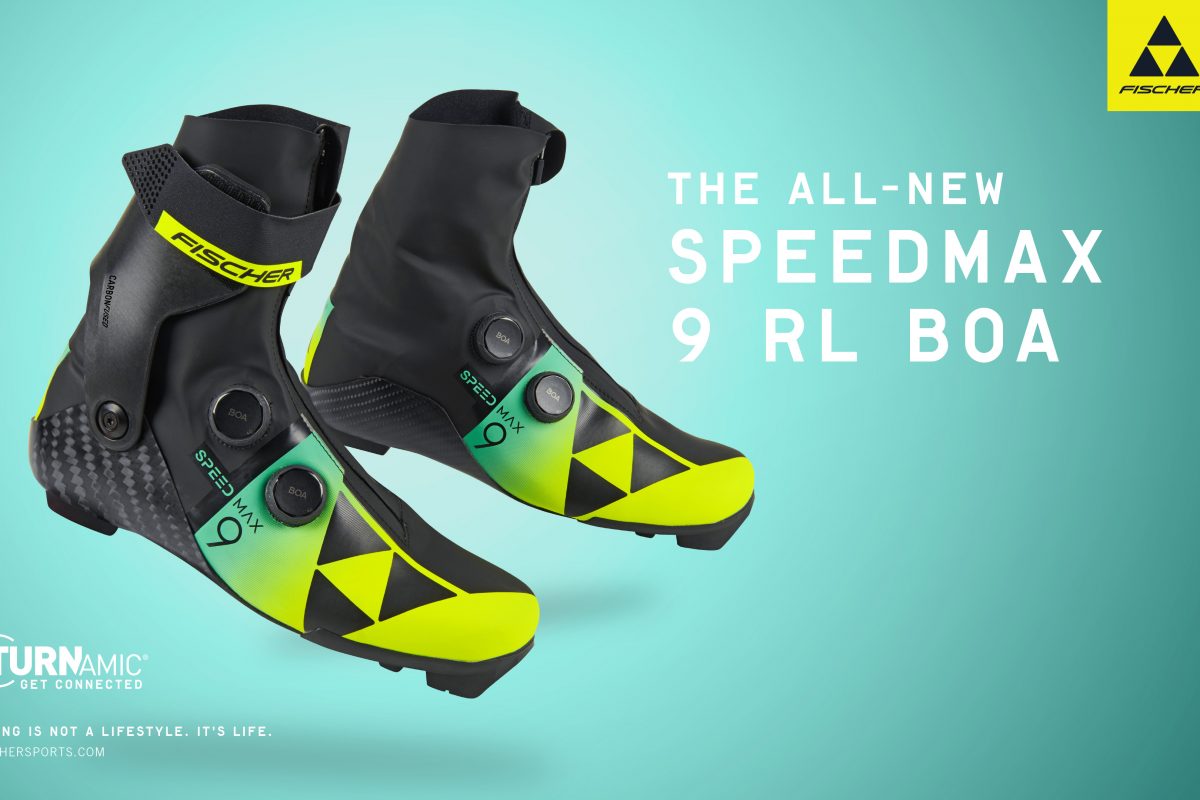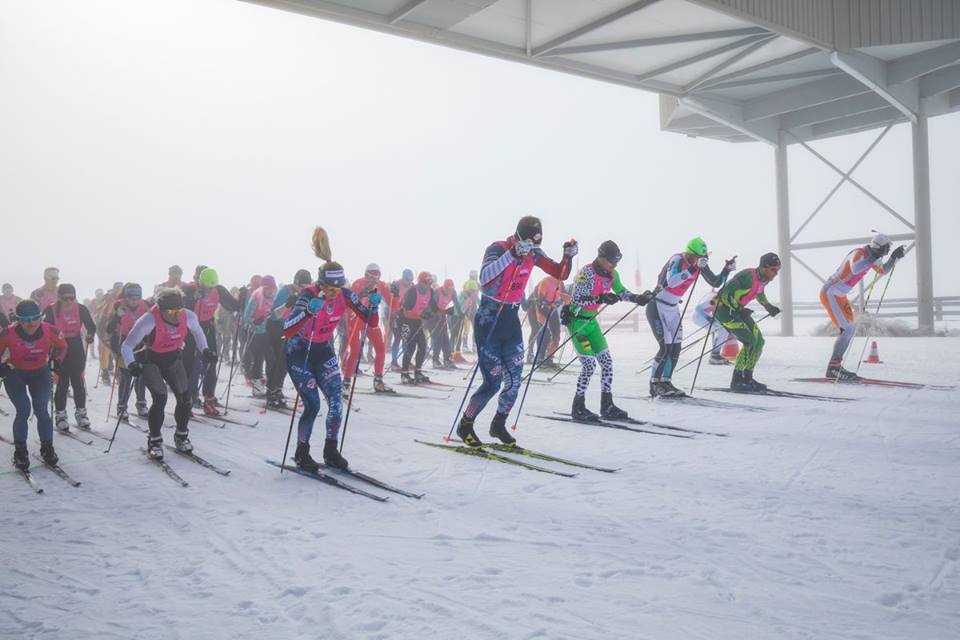
Visibility was thin and temperatures were below freezing last Saturday at the Snow Farm. Opaque white clouds of fog swept over the landscape near Wanaka, New Zealand, showcasing a skyline that seemed to play on the country’s largest historical farm industry: sheep. If bluebird skies and sun had greeted competitors in previous years, racers in the 2017 Merino Muster experienced temperatures around -5 degree Celsius (23 Fahrenheit) and a four-meter radius of visible track, then fog, for most of the 42-kilometer marathon.

The flutter of his own pole grips passing in his peripherals might have been the only company U.S. Ski Team (USST) A-team member Simi Hamilton saw during the race, had it not been for American Brian Gregg and Australian Phillip Bellingham.
The two contenders followed Hamilton from the start, and within the first few kilometers, all three had broken away from the rest of the 80+ men’s field to form a lead group. Together, the two Americans and Australian forged through the next 40 k, taking turns leading through the day’s scrim that hid the panoramic views of the Pisa mountain range that surround the Snow Farm.
“It was incredibly foggy all morning,” Hamilton wrote in an email. “I think we would have all gotten a little lonely out there if we had been skiing on our own.”
The trio kept each other company for the entirety of the race, but by the final two kilometers, Hamilton had staked his spot in the front. As Hamilton headed into the finishing stretch, both Bellingham and Gregg pushed to keep up with his pace. He ultimately held off Gregg by a second and Bellingham by 2 seconds to take the win with a finishing time of 1 hour, 40 minutes and 33 seconds.
“My energy felt good both years, but last year I had trouble accessing my sprint/[Level 4] gear in the final 2 kilometers of the race,” Hamilton wrote. “This year, I felt more comfortable skiing level 3 and I found that it was much easier to access my sprint gear at the very end.”
The victory is Hamilton’s first in the Merino Muster, which has been running for 23 years, the last three of which its been part of the Worldloppet marathon series. He first raced the marathon last season and finished second to his then-teammate Noah Hoffman (who won in 1:45:08 by 23 seconds over Hamilton). Upon returning, Hamilton had some specific objectives.
“The primary goal (both last year and this year) is to get in a really solid level 3 workout, with a hard effort at the very end,” Hamilton wrote. “It’s great terrain to be able to do that on because it’s all very rolling and you can maintain a really consistent effort the whole time without burying yourself too deep. And I think it’s always important to put on a race bib this time of year from time to time in order to start getting back into the race routine before the season really starts.”

Gregg’s second-place result came at his first Merino Muster, an event he was able to enter since he was in New Zealand for a training camp with his wife and Team Gregg teammate, Caitlin Gregg. The two arrived in New Zealand on Aug. 22 and planned to train there until the second week of September.
“Our dates ended up aligning with the USST camp dates as well and it has been a lot of fun joining them for workouts,” Brian wrote. “At the start of the second week down here athletes from Craftsbury, Stratton and Sun Valley arrived so we have had a large US representation. My brother and sister in law also made the trip down to race the Muster and help support our training. They both work remotely for their companies and it has been a blast to have them here with us.”
While he indicated that his summer training had been going well, the race itself was an invaluable opportunity for Gregg to tackle technique. Following Hamilton for an extended hard effort was one of his primary aims, not to mention testing his sprint speed against one of the U.S.’s top sprinters.
“One of my specific goals for this race was to ski with Simi,” Gregg wrote. “I think he is one of the better technical skiers in the world especially in V2 and following his smooth rhythm has been helpful for my own technique. Technical adaptations on snow has been my biggest goal of the camp and the race offered a focused 1 hour and 40 minutes of that.
“Swapping leads with Simi allowed me the opportunity to make technical adjustments through mimicry and then I could take the lead and make the technique more my own,” Gregg continued. “Although my goal was also to win the race I can hardly complain about being able to match the finishing sprint of a World Cup Winner.”
Bellingham, an Australian national team member, rounded out the men’s marathon podium in third, just two seconds out of first. A week prior to the Merino Muster, Bellingham competed in the 2017 Kangaroo Hoppet in Falls Creek, Victoria, where he placed second to American Miles Havlick.
Diggins 1st Woman, 4th Overall
In the women’s 42 k race, which started with the men, USST A-team member Jessie Diggins took the win with a time of 1:51:42 for fourth place overall. Diggins explained that while she was able to ski with the front group of men for the first few kilometers, she eventually settled into a pace that was more her own.

“We all started together but after 3-4km I knew I couldn’t hang with the lead guys the whole race, so I dropped back a bit,” Diggins wrote in an email. “I didn’t have to ski alone though, which was really nice!”
For much of the race, Diggins skied with Estonian Joosep Tammeme, a change from last season when she paired with her USST teammate Liz Stephen for most of the marathon.
“Last year was super fun because I got to ski with Liz the entire race,” Diggins wrote. “This year I had a really nice Estonian man to partner with but nobody can replace Liz Stephen!”
Thirty-one seconds behind Diggins, Tammeme, the fourth male, finished fifth.
With the Merino Muster behind her, Diggins will look to finish off the remainder of the USST’s three-week training block in New Zealand.
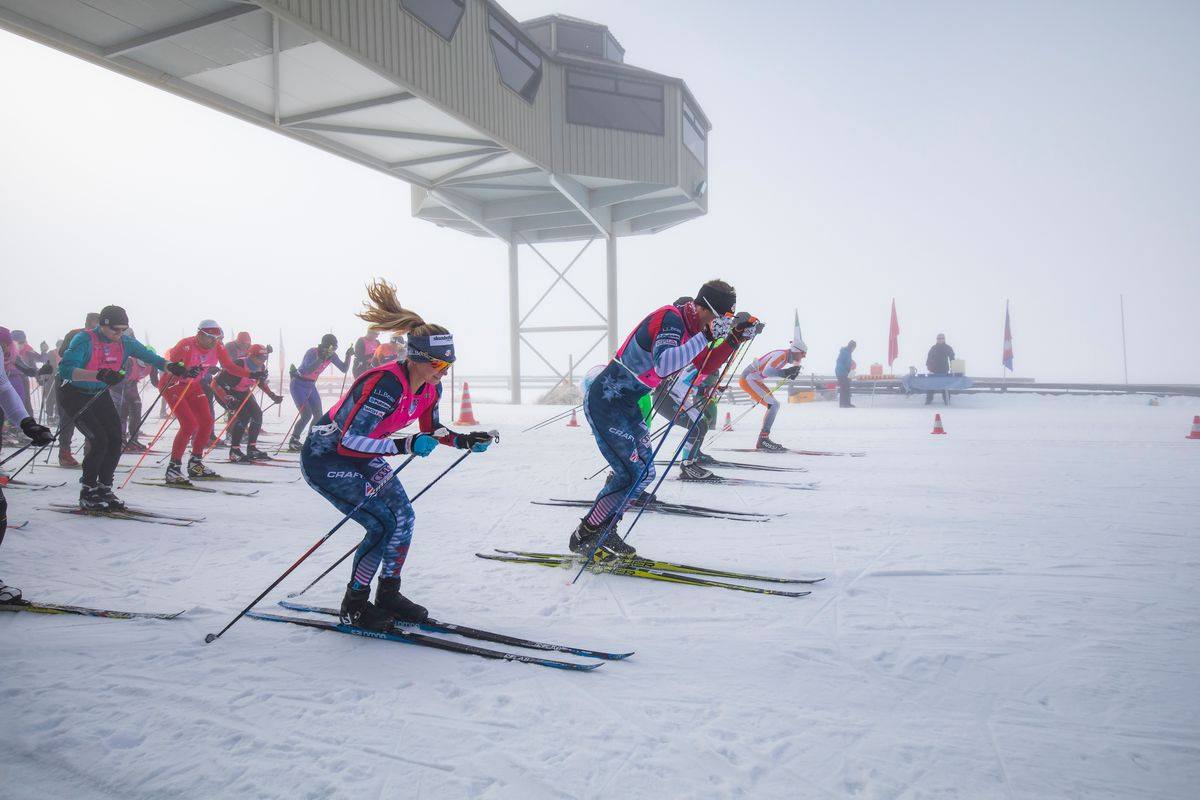
“The Merino was a fun way to get a long intensity session in during the week and ski hard while also enjoying the feeling of racing again!” Diggins wrote. “Huge, huge thanks to the entire crew here at the Snow Farm. They always treat us so well and make sure the trails are groomed perfectly for great training. This is my favorite camp so I’m really grateful to them for making space for us down under!”
The second woman after Diggins, 10 minutes and 17 seconds back, was retired American biathlete Hannah Dreissigacker, who has been working at the Snow Farm over the past few months. Dreissigacker, 30, explained that the race was her first since her retirement in the spring of 2016, and though she had remained relatively active leading up to it, gunning for the win wasn’t a goal.
“I’ve been doing a variety of work in the office as well as coaching and instructing and I’ve been trying to get out and ski whenever I can,” she wrote in an email. “But I definitely went into the race with low expectations.”
The Vermont native, instead saw the race — which ended up being her longest workout of the Southern Hemisphere’s winter — as more of an opportunity to do something she loved: skiing.
“The race split up immediately for me — I knew better than to try to stay with Jessie at all,” Dreissigacker wrote. “I skied with an older Russian skier, and then by myself, keeping the pace comfortable and I was very happy to feel good the whole time! There was some low-visibility off the start but the trails were in great condition and it was a fun first race as a ‘master blaster’.”
Rounding out the women’s podium in third (+17:24) was American and 2016 Bates College graduate Britta Clark.
In the 21 k “Snow Rake”, USST A-team member Sophie Caldwell took the overall win in a time of 51:21. Just one second behind her was Caitlin Gregg in second place, while the third woman was U.S. Paralympics Nordic Head Coach Eileen Carey (+5:48). The first man in third overall (+4:44) was U16 skier Campbell Wright, of New Zealand.
Gabby Naranja
Gabby Naranja considers herself a true Mainer, having grown up in the northern most part of the state playing hockey and roofing houses with her five brothers. She graduated from Bates College where she ran cross-country, track, and nordic skied. She spent this past winter in Europe and is currently in Montana enjoying all that the U.S. northwest has to offer.

